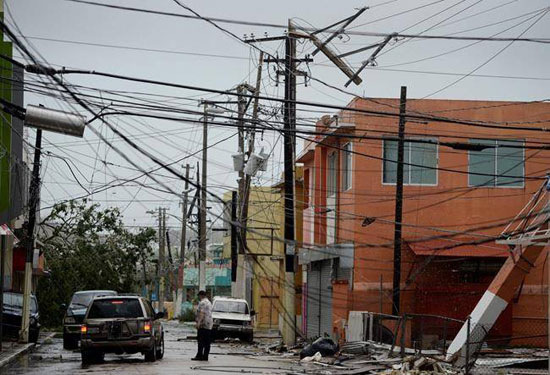3 Months After The Hurricane, One-Third Of Puerto Rico Is Still Without Power

More than 90 days after Hurricane Maria ravaged Puerto Rico, around one-third of the U.S. territory remains without power.
At least 34 percent of the island was still in the dark on Thursday, according to Puerto Rican government statistics. Gov. Ricardo Roselló initially expected 95 percent of the island’s power to be restored by mid-December. But the Army Corps of Engineers has since extended the timetable to late February or early March, blaming terrain challenges, logistical issues and a decades-old power grid for the delay.
Officials said full power restoration on the island likely won’t happen until the end of May.
Roselló “set an aggressive timeline, but we know it will take significant time to restore power to the majority of people,” Jay Field, a spokesman for the Army Corps of Engineers, told HuffPost.
The immense devastation caused by Maria’s 150-plus mph winds wreaked havoc on an already “very weak and fragile” electrical system, according to José Sánchez, director of the Army Corps of Engineers’ task force for power restoration in Puerto Rico.
“It has some aging issues, some maintenance issues, some lack-of-funding issues that all got together and became probably the perfect storm for Puerto Rico in creating that destruction around the island,”Sánchez said in a video posted Wednesday to the Federal Emergency Management Agency’s Facebook account.
Some 50,000 power poles are needed to restore electricity to the thousands of families still in the dark. In an average setting, most crews can install six to seven poles a day, Sánchez said. But in Puerto Rico, where mountain ridges and uncooperative weather often hinder progress, it can take seven to 10 days to install a single pole, he said.
“We have hundreds of crews right now working,” said Sánchez. “It’s not easy.”
The Army Corps of Engineers is working to support the Puerto Rico Electric Power Authority, which Sánchez explained is “ultimately responsible for their system and for bringing power to the people of Puerto Rico.” HuffPost contacted PREPA regarding the delays and was told the agency “continues to refine its initial master restoration plan,” which was laid out shortly after Maria hit the island.
“Workers have continued to uncover significant damage to the island’s electric infrastructure that in many instances requires wholesale rebuilding,”PREPA’s executive director, Justo González Torres, said in a statement sent to HuffPost on Thursday.
“We understand just how difficult it has been for our citizens to be without power for so long and commit to continuing to do all we can to ensure PREPA has the necessary resources to complete this unprecedented power restoration effort,”he added.
“As everyone knows, the US Corps of Engineers has had delays with the transportation of materials and brigades. That also delayed the estimates.”
González Torres was appointed interim director of PREPA after Ricardo Ramos resigned from the post in November.
Ramos was involved in the highly criticized decision to award Whitefish Energy, a small firm based in Montana, a $300 million contract to restore the island’s power grid. That contract was canceled in late October amid concerns over the two-year-old company’s limited experience and suspect connections to the Trump administration, as well as the lack of transparency surrounding the contract’s bidding process.
Poor conditions on the island, including the lack of electricity and limited access to drinking water, have prompted a mass exodus to the U.S. mainland. More than 200,000 Puerto Ricans have relocated to Florida in the aftermath of Maria, with more thought to have moved to other U.S. areas with established Puerto Rican communities.
Residents who stayed behind face an everyday struggle, buying and fueling generators that only partially power their homes. Ektor Gomez, 51, and his San Juan neighborhood have been without power since Hurricane Irma hit the island in early September, even before Maria.
For two months, Gomez depended on a $800 generator he waited nine hours in line to buy at Home Depot in the aftermath of the storms. Then the machine gave out, and he was forced to purchase a second generator for $2,000 while he got the first one fixed.
“It’s a small generator. Every day I have to go out to buy fuel to fill it up, so that when I get home, I can have power to at least be able to turn on a fan to sleep,”he told HuffPost on Thursday, adding that the second generator can only power a fan, his refrigerator and his television.
There are around 500 households in his area in a similar situation, the majority of them made up of senior citizens, Gomez said. The community recently protested to officials over the delays in power restoration, and he said that protest is the reason workers began trying to restore power in the area this week.
“Our community is a community of older residents who aren’t able to buy generators or aren’t able to go buy fuel [for generators] or change the oil and filters,”Gomez said about why he decided to pressure officials.
“They’re the people that are most affected.”

